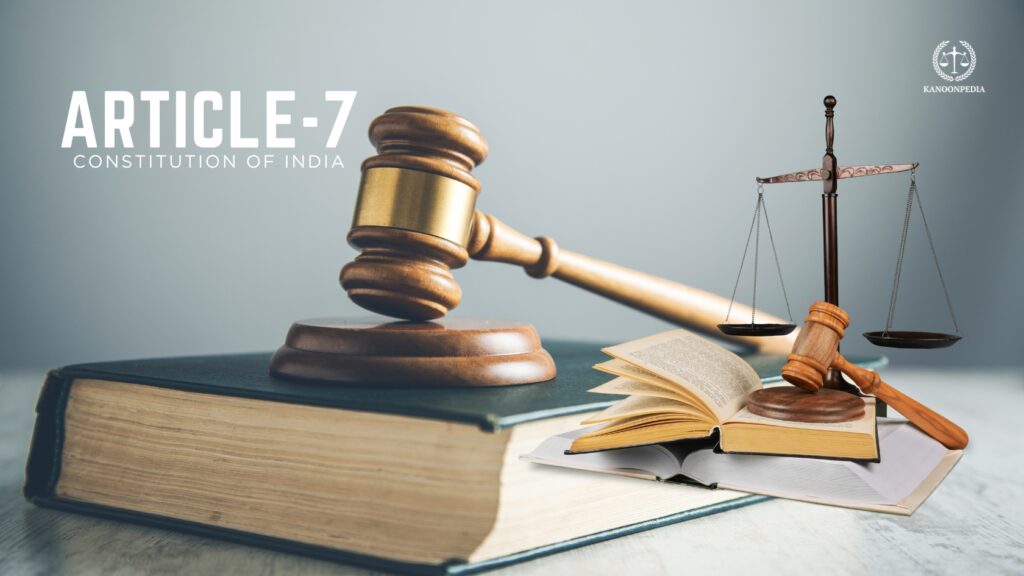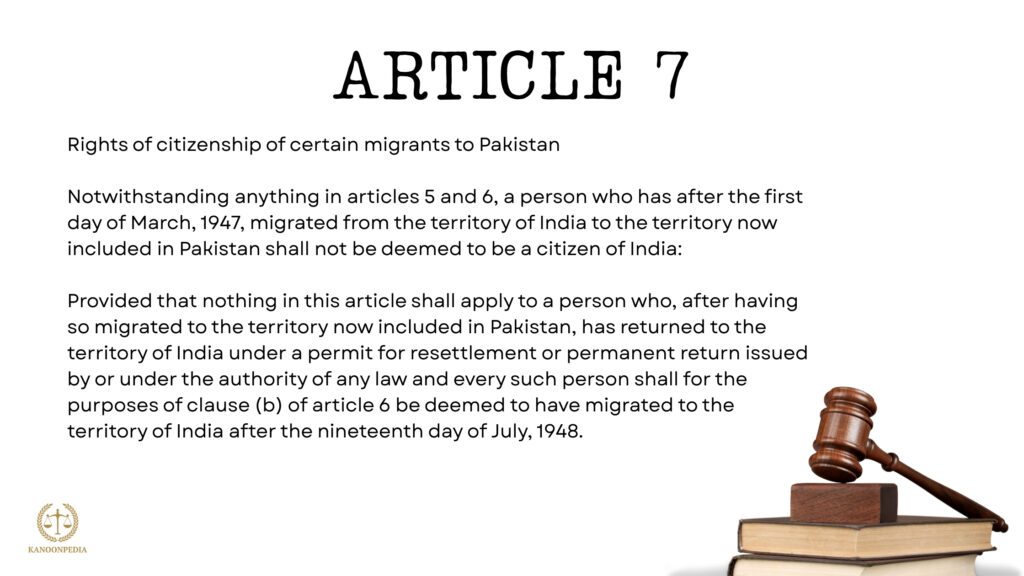Article 7 of Indian Constitution addresses the citizenship status of individuals who migrated from India to Pakistan after partition. This provision was crucial in determining who would not be considered citizens of India at the commencement of the Constitution, with certain exceptions for those who returned under specific conditions.

Table of Contents
Article Bifurcation & Textual Analysis
Article 7 states: “Notwithstanding anything in articles 5 and 6, a person who has after the first day of March, 1947, migrated from the territory of India to the territory now included in Pakistan shall not be deemed to be a citizen of India: Provided that nothing in this article shall apply to a person who, after having so migrated to the territory now included in Pakistan, has returned to the territory of India under a permit for resettlement or permanent return issued by or under the authority of any law and every such person shall for the purposes of clause (b) of article 6 be deemed to have migrated to the territory of India after the nineteenth day of July, 1948.”

This provision can be bifurcated into three key components:
- Overriding Effect: The phrase “Notwithstanding anything in articles 5 and 6” establishes that Article 7 takes precedence over the general citizenship provisions in Articles 5 and 6 for those who migrated to Pakistan.
- General Rule of Exclusion: The main clause establishes that individuals who migrated from India to Pakistan after March 1, 1947, shall not be deemed citizens of India, effectively terminating their Indian citizenship.
- Exception for Returnees: The proviso creates an exception for those who, after migrating to Pakistan, returned to India under official permits for resettlement or permanent return. Such persons are deemed to have migrated to India after July 19, 1948, making them eligible for citizenship under Article 6(b).
The significance of March 1, 1947, as the cut-off date is noteworthy, as it precedes the actual partition (August 1947), suggesting that the framers intended to address migration motivated by the anticipated partition rather than just post-partition movement.
Landmark Judicial Interpretations
Kulathil Mammu vs. The State of Kerala (1966)
Facts: Aboobacker was born in Kozhikode to Indian citizen parents and moved to Pakistan in 1948 at age 12. He returned to India briefly in 1954 and 1956 using a Pakistani passport. In 1964, he was found in Kozhikode without valid travel documents.
Legal Questions: Whether Aboobacker’s movement to Pakistan constituted “migration” under Article 7, and whether he could claim Indian citizenship.
Court’s Reasoning: The Supreme Court held that “migrated” in Article 7 is used in a broad sense, meaning moving from one place to another regardless of the intention to reside permanently. This interpretation excluded involuntary movements or short-term relocations. The Court concluded that migration, like domicile, involves both fact and intention.
Ratio Decidendi: “Migration under this Article involves both the fact of moving from one place to another and the intention to reside in the new place, similar to the concept of domicile.”
Case of Woman Who Traveled to Karachi
Facts: A woman traveled to Karachi in July 1948, leaving her husband in India. She claimed her trip was for medical reasons but obtained a temporary permit stating she was domiciled in Pakistan and a Pakistani national. She returned to India in December 1948 but went back to Pakistan in April 1949 after her permit expired.
Court’s Reasoning: The Supreme Court held that she had indeed migrated from India after March 1, 1947, and clarified that Article 7 overrides Article 5, making no exceptions even for a wife migrating to Pakistan while her husband stayed in India.
Key Observation: “It makes no exception for family relationships, and even a temporary migration to Pakistan after March 1, 1947, can result in the loss of Indian citizenship if the person does not return under a proper resettlement permit.”
Quotable Content for Examinations
From Kulathil Mammu vs. The State of Kerala:
“The term ‘migrated’ in Article 7 is used in a broad sense, meaning moving from one place to another with the intention to reside, and is not limited to involuntary movements or short-term relocations.”
“Migration, like domicile, involves both fact and intention, emphasizing that Articles 6 and 7 address the status at the commencement of the Constitution.”
Constitutional expert Durga Das Basu observed: “Article 7 represents the other side of the constitutional response to partition migration, establishing clear criteria for determining who would not be considered citizens of India while providing a pathway for those who wished to return.”
Historical Context & Evolution
Article 7 was introduced as Draft Article 5AA in the Constituent Assembly and was extensively debated on August 10, 11, and 12, 1949. The Chairman of the Drafting Committee proposed its insertion to regulate the citizenship claims of individuals who had migrated to Pakistan after partition.
During these debates, some members criticized the article, arguing that those who had migrated to Pakistan had already transferred their loyalty to another country and should be treated like other foreigners, acquiring citizenship through naturalization. They felt the permit system was too lenient. However, proponents countered that permits would not be issued casually and emphasized India’s commitment to resettlement promises made to these migrants.
The Chairman highlighted that withdrawal from this promise would cause grave injustice. Additionally, concerns were raised about property left behind by migrants, classified as ‘evacuee property’. It was clarified that citizenship and property rights were separate under both international and domestic law. The Assembly ultimately adopted the Article without any amendments on August 12, 1949.
Practical Applications & Contemporary Relevance
Article 7 had significant practical implications during the post-partition period:
- Citizenship Determination: It provided clear criteria for determining whether individuals who moved to Pakistan after partition could claim Indian citizenship upon return.
- Permit System: The provision established a legal pathway through the permit system for those who wished to return to India after initially migrating to Pakistan.
- Property Rights: While Article 7 addressed citizenship status, it indirectly affected property rights, as non-citizens could not claim certain property rights in India.
- Intergenerational Impact: The citizenship determination under Article 7 extended to descendants, affecting their status and rights in India.
The provision continues to have relevance in contemporary citizenship discussions, particularly in cases involving descendants of those who migrated during partition and in the broader context of India’s approach to citizenship based on migration patterns.
Comparative Constitutional Perspective of Article 7 of Indian Constitution
Article 7 stands in contrast to Article 6, which deals with migrants from Pakistan to India:
- Asymmetric Approach: While Article 6 provides a pathway to citizenship for those who migrated to India from Pakistan, Article 7 generally denies citizenship to those who migrated from India to Pakistan, with the exception of those who returned under resettlement permits.
- Intention-Based Distinction: This asymmetry reflects the constitutional framers’ view that migration to Pakistan represented a choice to belong to a different nation, while migration to India represented a choice to belong to India.
- Unique Historical Response: Few constitutions worldwide contain such specific provisions addressing migration between newly formed nations, making Articles 6 and 7 unique responses to the unprecedented circumstances of partition.
Critical Evaluation
Strengths:
- Provided legal clarity during a chaotic historical period of mass migration
- Created a structured pathway for returning migrants through the permit system
- Balanced national security concerns with humanitarian considerations for returnees
Limitations:
- Created potential hardships for those who migrated to Pakistan but later wished to return without formal permits
- The cut-off date of March 1, 1947, may have seemed arbitrary to some affected individuals
- The provision created a complex citizenship determination process that led to numerous legal challenges
- Made no exceptions for special circumstances such as family relationships or temporary visits
Examination & Advocacy Strategy
For UPSC and Judiciary Examinations:
- Distinguish Between Articles 5, 6, and 7: Clearly articulate that Article 7 creates an exception to Articles 5 and 6 for those who migrated to Pakistan after March 1, 1947.
- Emphasize the Permit System: Highlight the importance of the resettlement or permanent return permit as the only pathway to citizenship for those who initially migrated to Pakistan.
- Cite Key Cases: Reference Kulathil Mammu vs. The State of Kerala to illustrate the judicial interpretation of “migration” under Article 7.
- Connect with Constitutional Values: Discuss how Article 7 reflects the constitutional values of national integrity while providing humanitarian pathways for returnees.
For Legal Advocacy:
- Challenging Citizenship Denial: When representing clients denied citizenship under Article 7, focus on whether their movement to Pakistan constituted “migration” as interpreted by the courts or whether they returned under valid permits.
- Establishing Return Status: For those who returned from Pakistan, emphasize the validity of their resettlement permits and their compliance with the conditions of return.
- Intergenerational Claims: Address the citizenship status of descendants of those affected by Article 7, particularly in cases where ancestral migration patterns are complex.
Article 7 of Indian Constitution represents a critical constitutional response to the unprecedented challenges of partition, reflecting the delicate balance between national identity, security concerns, and humanitarian considerations during one of the most tumultuous periods in Indian history. Its provisions continue to shape the citizenship status of individuals with historical connections to both India and Pakistan, demonstrating the enduring impact of constitutional choices made during India’s founding moment.
[…] overriding effects of Articles 7 and 9 created exceptions to Article 5’s citizenship […]
[…] compared to Article 7, which deals with migrants to Pakistan, Article 6 reflects a more sympathetic approach. Article 7 […]